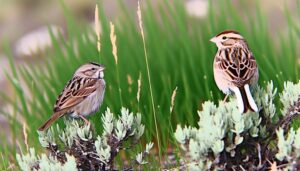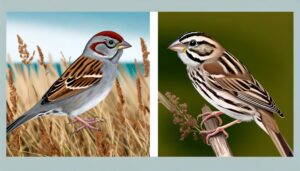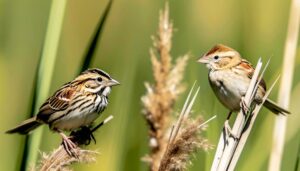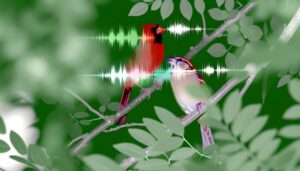House Sparrow Vs Bluebird – 3 Key Differences
The House Sparrow exhibits brown and gray feathers with a stout body and a robust, conical beak, adapted for urban and rural habitats globally. In contrast, the Bluebird displays vibrant blue and reddish-orange hues, with a slender and streamlined physique more suited to North America's rural and open areas.
House Sparrows thrive in human-altered environments, often using buildings for nesting, while Bluebirds prefer natural cavities or man-made boxes on forest edges. Diets reflect these differences: omnivorous House Sparrows scavenge grains and insects, while insectivorous Bluebirds hunt insects and forage for berries.
Insights into their rivalry and conservation reveal more intriguing details.

Key Takeaways
- House Sparrows thrive in urban areas, while Bluebirds prefer open, rural environments with scattered trees.
- House Sparrows are omnivorous and feed on grains, seeds, and human food scraps, whereas Bluebirds primarily eat insects and berries.
- House Sparrows are aggressive nest usurpers, often outcompeting Bluebirds for nesting sites.
- House Sparrows have brown and gray feathers; Bluebirds display vibrant blue and reddish-orange hues.
- Conservation efforts for Bluebirds include specific nest box designs and habitat management to reduce House Sparrow competition.
Physical Characteristics
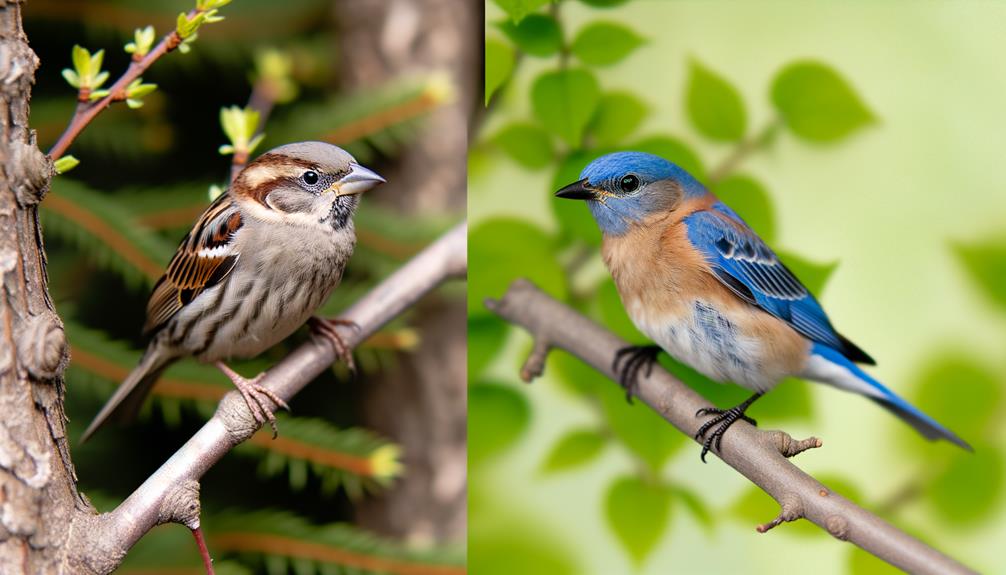
When comparing the physical characteristics of the House Sparrow and the Bluebird, one can immediately notice the stark differences in their plumage coloration and body morphology.
The House Sparrow (Passer domesticus) exhibits a more muted palette, with brown and gray feathers, and a stout body structure. In contrast, the Bluebird (Sialia spp.) showcases vibrant blue and reddish-orange hues, with a slender, streamlined physique.
The Sparrow's shorter wings and tail differ significantly from the Bluebird's longer, more pointed wings and tail, built for agile flight. Additionally, the Sparrow's beak is robust and conical, suited for seed consumption, while the Bluebird's beak is slender and slightly curved, ideal for catching insects.
These differences highlight their adaptations to distinct ecological niches.
Geographic Distribution
The distinct physical characteristics of the House Sparrow and Bluebird are mirrored in their geographic distribution, with House Sparrows inhabiting a broad range across urban and rural areas worldwide, while Bluebirds are primarily found in North America, favoring open woodlands and grasslands.
House Sparrows have adapted to diverse environments, including:
- Urban centers
- Agricultural fields
- Coastal regions
- Suburban gardens
- Industrial areas
In contrast, Bluebirds exhibit a more specialized distribution. Eastern, Mountain, and Western Bluebirds each occupy specific niches within North America. Eastern Bluebirds thrive in the eastern United States, while Mountain Bluebirds prefer the high-altitude regions of the Rockies. Western Bluebirds inhabit the Pacific coast and southwestern states.
This comparative analysis underscores their adaptability and ecological preferences, crucial for understanding their roles in different ecosystems.
Habitat Preferences
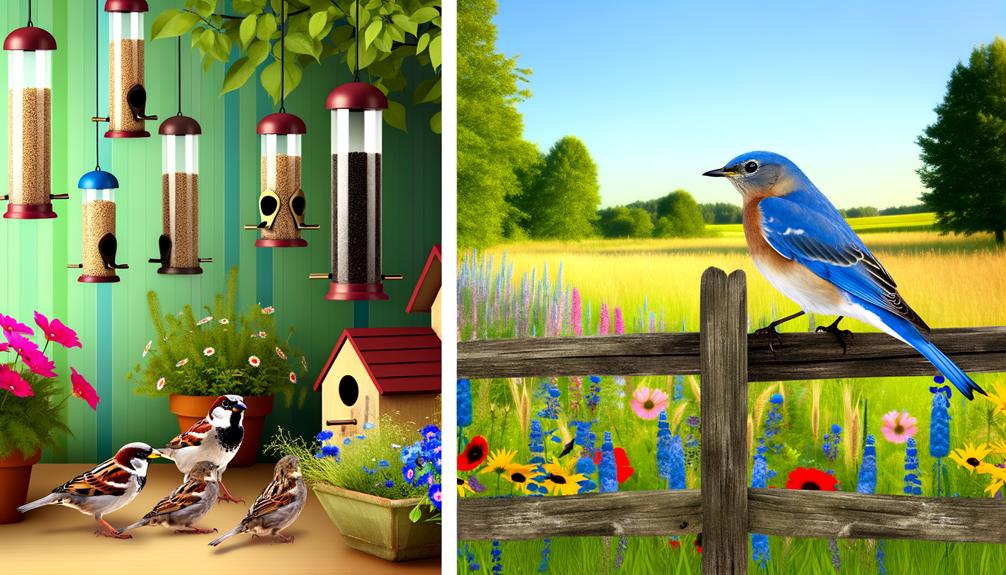
Observing the habitat preferences of House Sparrows and Bluebirds reveals significant differences rooted in their ecological adaptations and requirements.
House Sparrows thrive in urban and suburban landscapes, exploiting human-altered environments for food and shelter. Their synanthropic nature enables them to nest in buildings, feed on scraps, and coexist closely with humans.
In contrast, Bluebirds prefer open, rural areas with scattered trees and low vegetation. They inhabit grasslands, orchards, and forest edges, where they forage for insects and berries.
This divergence in habitat preference underscores their distinct ecological niches: House Sparrows are generalists comfortably maneuvering anthropogenic spaces, while Bluebirds are more selective, seeking habitats that support their insectivorous diet and perching needs.
These differences illustrate their unique survival strategies.
Nesting Behaviors
In examining their nesting behaviors, one can notice House Sparrows often construct their nests in cavities such as building crevices and nest boxes, while Bluebirds prefer natural cavities in trees and man-made nest boxes in open fields.
House Sparrows use a variety of materials, including:
- Grass
- Feathers
- Paper
- String
- Twigs
Bluebirds, on the other hand, favor fine grasses and pine needles.
House Sparrows are known for aggressively taking over nest sites, often outcompeting native birds. Bluebirds exhibit more selective nesting preferences, requiring specific dimensions and placement for their cavities.
This difference in nesting behavior has significant implications for their respective populations, influencing their adaptability and interactions with other species.
Diet and Feeding Habits
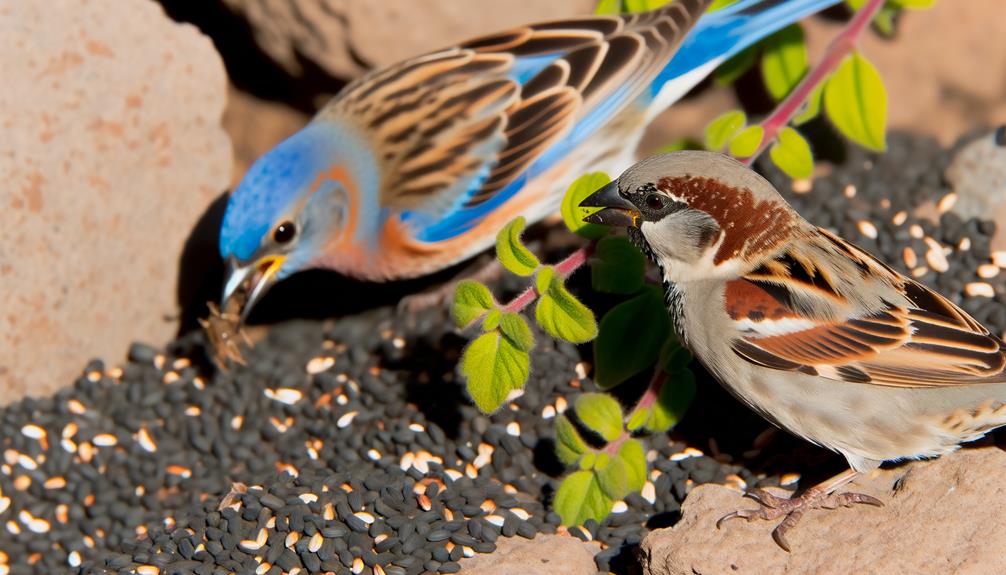
House Sparrows and Bluebirds exhibit distinct dietary preferences and feeding behaviors. House Sparrows primarily consume grains, seeds, and insects, showing a versatile omnivorous diet.
Bluebirds, on the other hand, focus on a diet rich in insects and berries, reflecting their insectivorous and frugivorous tendencies.
These feeding habits highlight the ecological adaptations each species has developed to thrive in their respective environments.
Varied Food Preferences
Unlike bluebirds, which primarily feed on insects and fruits, sparrows exhibit a broader diet that includes grains, seeds, and even human food scraps. Bluebirds' diet is highly specialized, focusing on high-protein insects and nutrient-rich berries, reflecting their insectivorous and frugivorous nature. In contrast, sparrows' omnivorous diet allows them greater flexibility in various habitats.
Key components of house sparrows' diet include:
- Grains and seeds: Commonly found in agricultural fields.
- Insects: Especially during breeding season for protein.
- Human food scraps: Often scavenged in urban areas.
- Fruits: Supplementary but not primary.
- Plants and weeds: Seeds from wild flora.
These dietary differences highlight the ecological adaptability of sparrows compared to the more niche feeding habits of bluebirds.
Feeding Behavior Differences
Examining the feeding behaviors of house sparrows and bluebirds reveals stark contrasts in their foraging strategies and dietary adaptability.
House sparrows exhibit a generalist feeding behavior, consuming a wide variety of seeds, grains, and insects. Their opportunistic nature allows them to thrive in diverse environments, from urban areas to rural landscapes.
Bluebirds, on the other hand, are more specialized insectivores. They primarily feed on insects like beetles, caterpillars, and grasshoppers, supplemented by fruits and berries. Bluebirds employ a sit-and-wait hunting strategy, watching for prey from a perch before swooping down.
In contrast, house sparrows forage actively on the ground or in vegetation. These differences underscore how each species has evolved unique feeding habits to maximize survival.
Vocalizations and Songs
Throughout the day, observers note that the vocalizations of the house sparrow exhibit a series of repetitive chirps, while the bluebird's songs are characterized by a melodious sequence of warbles and whistles.
The house sparrow's calls are more utilitarian, serving communication and alert functions. In contrast, the bluebird's vocalizations are intricate, showcasing a broader frequency range.
- House Sparrow: Monotonous, pragmatic chirps.
- Bluebird: Complex, musical warbles and whistles.
- Function: Sparrows often use calls for alarms; bluebirds use songs for territory and mating.
- Frequency Range: Sparrows have a narrower range; bluebirds, wider.
- Acoustic Complexity: Bluebirds exhibit higher complexity in songs.
This comparative analysis highlights the distinct acoustic behaviors influenced by their ecological roles.
Interaction With Humans
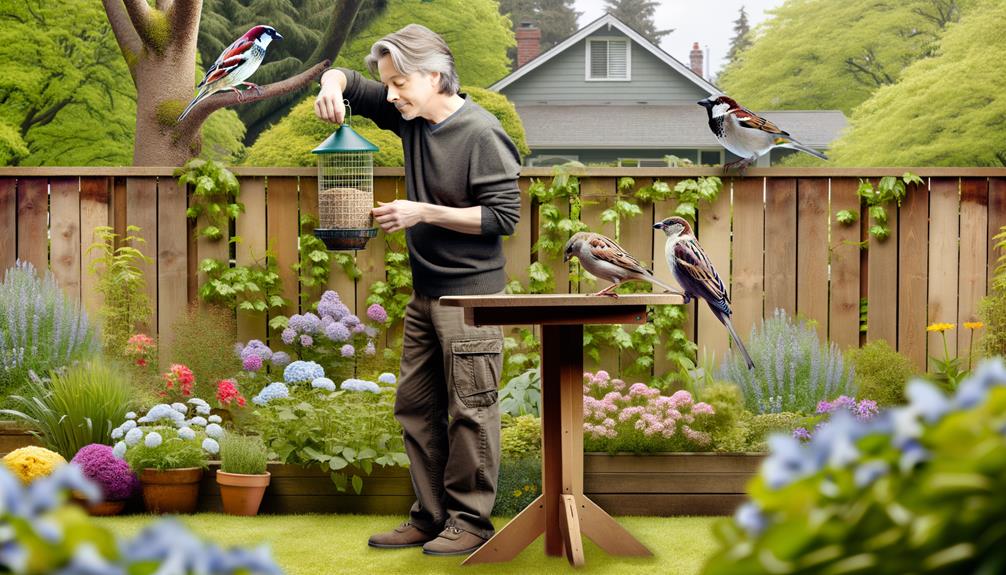
Both house sparrows and bluebirds interact with humans in distinct ways, reflecting their differing ecological adaptations and behaviors.
House sparrows, highly synanthropic, thrive in urban environments, frequently nesting in man-made structures. Their adaptability to human-altered landscapes demonstrates their ecological plasticity.
Bluebirds, on the other hand, prefer more open, rural areas and are often attracted to nest boxes provided by conservationists. Their interactions with humans are less invasive, focusing on habitat enhancement rather than exploiting urban niches.
These distinct interactions reveal how house sparrows exploit human proximity for survival, while bluebirds benefit from human efforts to preserve natural environments.
Such differences underscore the complex dynamics between avian species and human impact on their ecological niches.
Competition for Resources
The differing interactions of house sparrows and bluebirds with humans highlight a significant aspect of their ecology: their intense competition for limited nesting sites and food resources. House sparrows, being more aggressive and adaptable, often outcompete bluebirds for prime nesting spots. This competition manifests in several ways:
- Nest usurpation: Sparrows aggressively take over bluebird nests.
- Diet overlap: Both species feed on similar insects and seeds.
- Habitat encroachment: Sparrows adapt well to urban settings, pushing bluebirds to the periphery.
- Reproductive success: Sparrow dominance can reduce bluebird fledgling success.
- Behavioral dominance: Sparrows exhibit more aggressive territorial behaviors.
These competitive interactions highlight the fragile balance both species must navigate to thrive in overlapping habitats.
Conservation Efforts
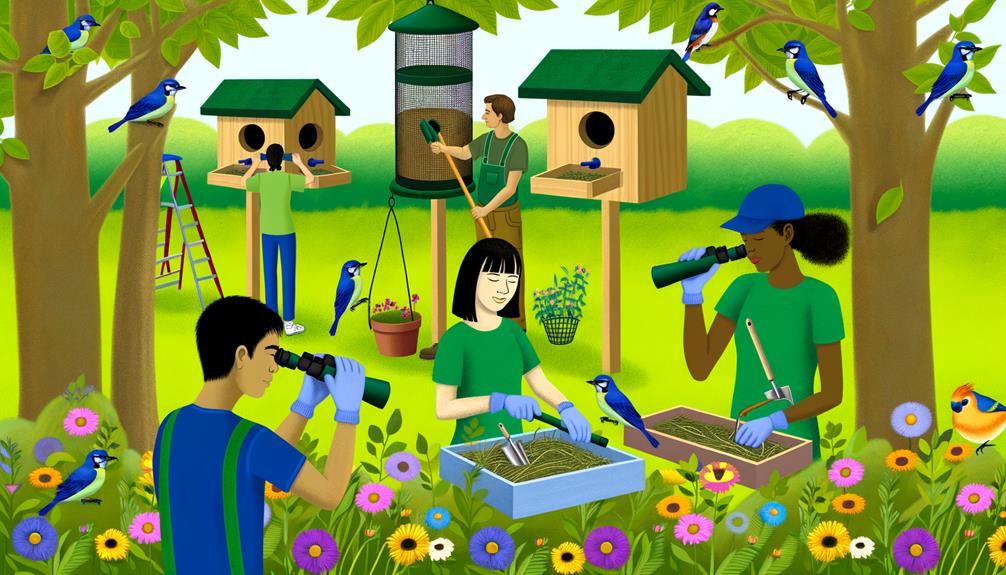
Conservationists employ targeted strategies to mitigate the competitive pressures between house sparrows and bluebirds, aiming to preserve the delicate ecological balance and guarantee the survival of both species.
They install nest boxes specifically designed for bluebirds, featuring entrance holes that exclude the larger house sparrows. Additionally, they engage in habitat management, promoting native flora that supports bluebird foraging while reducing house sparrow nesting sites.
Monitoring programs track population dynamics, providing data to adapt strategies effectively. In extreme cases, sparrow control measures, such as trapping and removal, are implemented to protect bluebird nests.
Conclusion
To sum up, while house sparrows and bluebirds share certain similarities, their differences are as distinct as night and day.
The sturdy house sparrow thrives in urban settings, often outcompeting the more delicate bluebird, which prefers open meadows and woodlands.
Their contrasting nesting behaviors, diets, and vocalizations highlight their unique adaptations.
Effective conservation efforts must take into account these differences to guarantee both species can coexist and flourish, preserving the ecological balance they each contribute to.

